The story of Sterling Essentials starts with horses in the Pacific Northwest. When founder Teal’s horse was injured one winter, they found themselves spending more time in the tack room and worried if the wet winter weather would leave her tack covered in mold and mildew. She and her family looked around for a leather care product that would do the trick, but everything contained irritating chemicals. Their horse had even more sensitive skin than people, and if the chemicals were irritating to humans, they would certainly irritate our horse.

Frustrated with the inability to find any natural leather care products, Teal and her husband decided to make their own! They believe that effective, high-quality leather care can be achieved without harsh and irritating chemicals. The Sterling Essentials brand was founded on the principle of a product line that protects the leather from the soggy and damp Pacific Northwest winter, while also nourishing during the dry summers.
After months of experimentation, a product that uses simple, natural ingredients, such as high-grade beeswax, food-grade natural oils, and top-of-the-line therapeutic essential oils was born. Not only do Sterling Essentials leather care products protect your leather, but they smell amazing too!
We sat down with founder Teal Shoop for details.
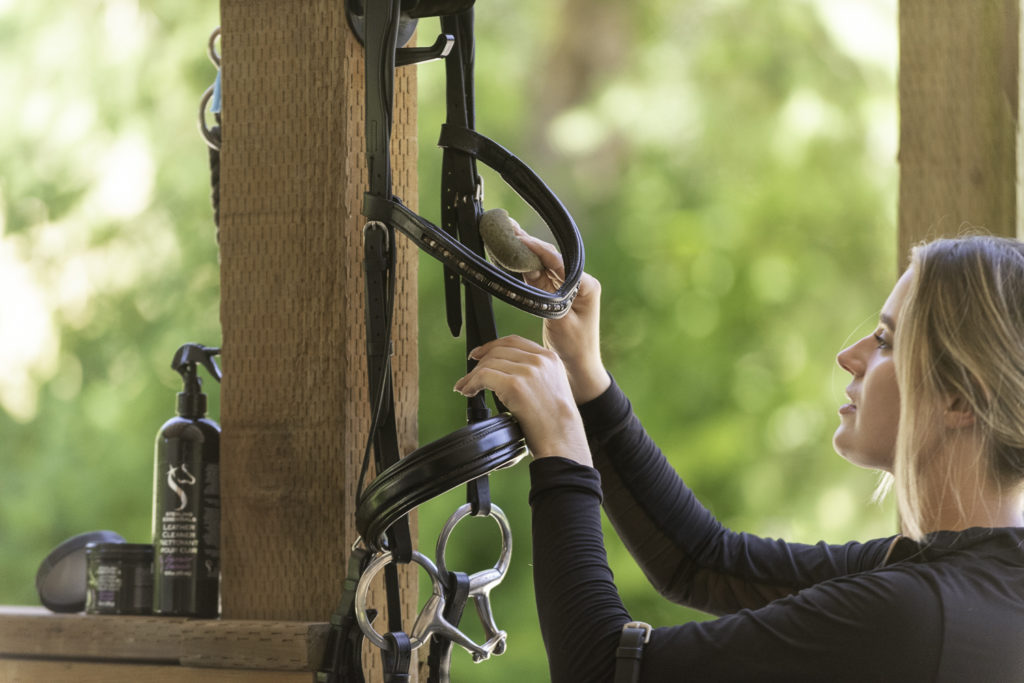
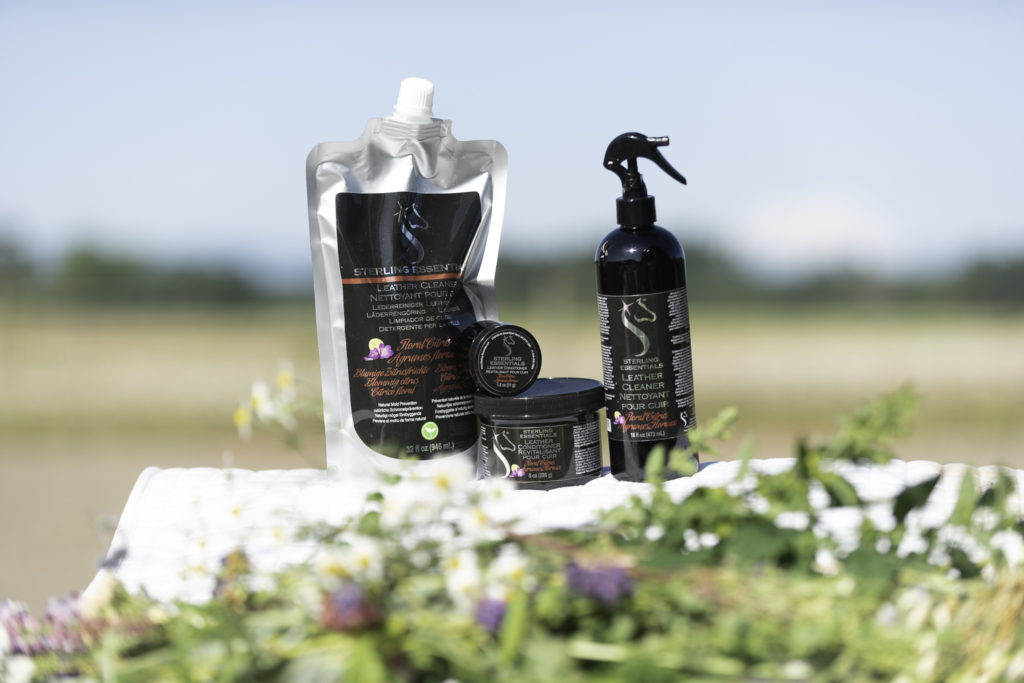
Could you share how you got into horses and the disciplines you participate in?
There is this tape recording my Mom made around when I was about 4 years old of our family playing some guessing game. And already then, you can hear me chattering away about horses and even donkeys. I think basically the answer I had to every guessing game question was something equine, much to both the amusement and befuddlement of my family. LOL!
So the bug began early, but where it came from is a mystery. None of my immediate or extended family ride or are at all interested in horses. However, I’m so grateful to my parents, and now my husband then indulged and supported me. I’m sure my Dad was annoyed many a time to come home from work to find he couldn’t get up the driveway because I’d filled it with makeshift jumps made out of buckets, yard rakes, and wheelbarrows that I was busily show jumping over on my imaginary steed.
Although my first lessons, around when I was 9, started in Western, I soon began gravitating to English. No doubt this was the pull to learn how to jump, which clearly filled my imagination early on. However, between lack of instructors in my area, high school, and heading to college, horses soon took a back burner and I didn’t get back into the saddle until my mid-20s. This was actually in a saddle seat barn while I was living outside Savannah, Georgia for a few years. But upon moving back to the Pacific Northwest, I soon switched to a hunter/jumper barn riding hunters, and that’s where I’ve focused ever since.
What made you decide to start Sterling Essentials?
Back in the day, one of my past horses began breaking out in hives along his girth line and on his face from contact with, what I then thought to be, the elite top-quality leather care products I was using at the time. You can imagine my surprise when while doing a little research for an effective but safe and gentle leather care brand to try I learned that many brands on the market, including those I trusted, contained irritating chemicals, toxins, and other harmful or counterproductive ingredients. Some even had turpentine!
So I threw those top-name leather care products in the trash and my mental wheels started turning. Because it’s not just about having clean tack, right? It’s really about ensuring the health of our horses, too. Don’t you agree?
With life’s ups and downs, it wasn’t until a few months later when a little bit of bad luck came along, that my brand vision really started to form. Another horse of mine became injured and was on stall rest for many months. Living in the Pacific Northwest, I found myself worrying that my saddle and other leather tacks would become moldy and mildewed in our wet winter. Again, I looked around for a leather care product that would do the trick, but once more, everything I found contained irritating chemicals, unhealthy, counterproductive, and environmentally unfriendly ingredients.
All of my horses, both past and current, have had even more sensitive skin than mine, and if these chemicals were irritating to me, they would certainly irritate my horses. Additionally, I bet most fellow equestrians can relate – but my horses were quite inquisitive and thoroughly enjoyed chewing on anything they could reach, including their leather reins. I didn’t want to worry about my horses ingesting any harmful products, so again I searched to no avail, for a leather care product on the market that didn’t contain potentially hazardous ingredients.
Frustrated with my inability to find any gentle, non-toxic, all-natural leather care products, I finally decided to make my own! I believed that effective, high-quality leather care could be achieved without harsh and irritating chemicals or unsafe ingredients. Also, I knew that fellow equestrians care just as deeply about their horse as I do about mine, so I thought there would be an interest in the horse community for a more natural and holistic leather care solution. But at the heart of it, my horses and my love for them were the true inspiration behind Sterling Essentials.
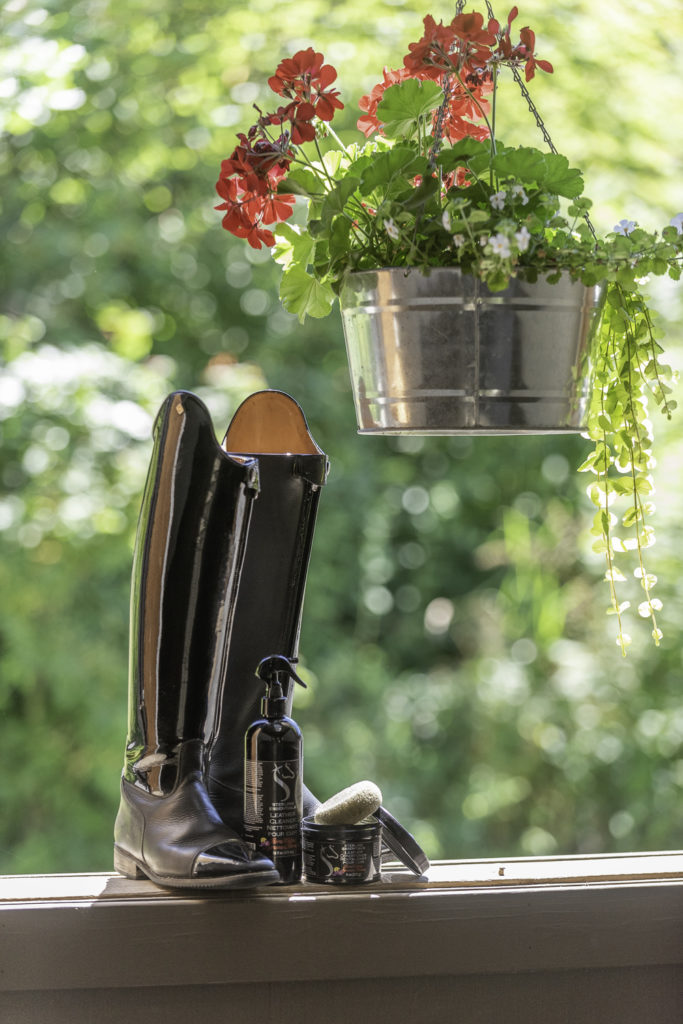
Describe your recommended/preferred leather care routine.
You take care of what you value. Well, for me that means taking care of my tack and protecting that investment. I mean, goodness knows, high-quality tack is not the smallest investment in the world, is it? LOL! Plus, my tack not only keeps me safe, but my horse safe, also. So although sometimes tack can seem like more of an accessory or we take it for granted, caring for it to me is definitely one of the very top horse care and horsemanship activities there is. I consider it part of my horse health care routine.
And what I always recommend is that riders care for their tack as they do for their horse – with a care routine tailored specifically for your tack’s needs and customized to your environment and climate.
Conscientious care always begins with gentle cleaning of tack, not missing any nooks or crannies, after every use. Sure, sometimes riders may think this takes a lot of time. But have they fully considered how a quick clean after each ride actually will save them time in the long run, use less elbow grease, and also use less leather cleaner? Because right after a ride, dirt, sweat, and grime hasn’t yet hardened and fully adhered to the leather. This makes it much easier to clean off. As you can imagine and probably know from experience, that is not the case days or many rides later when all that build-up has hardened and started also attracting bugs, dust, and other grime.
Additionally, even though I just adore my SE leather conditioner, I am definitely not a conditioner junkie! LOL! I do not condition my tack after each cleaning, although I know some riders are taught to condition religiously. Why do I not condition after each ride?
A key to leather health and longevity is maintaining just the right moisture level in the leather’s fibers. Given leather’s porous nature, it is very easy to over-condition your leather, resulting in oversaturated and stretched fibers and weakened and damaged leather. Additionally, over-conditioned leather creates a perfect feeding ground for mold, mildew, and other pests.
And this is where I really recommend tailoring leather conditioning specifically to your tack’s specific needs. The amount of conditioning your leather requires is greatly dependent on your circumstances, including your unique weather, temperature, and environment, as well as the brand, type, and condition of your leather.
For example, based on my dry central Oregon location I condition my full grain hunter/jumper saddle approximately 2-3 times per month during the summer, but about twice per month in the winter since my winters are low humidity. If you are in a more humid climate or a climate susceptible to mold and mildew, you may find that you will want to reduce your conditioning amount and frequency substantially. The leather’s fibers will naturally retain their moisture in these environments, and you will want to control the amount of moisture in the leather upon which mold likes to feed. Adversely, if you live in a very arid climate, you may need to dramatically increase the amount and frequency of conditioning.
In order to find and keep this moisture balance, you need to rely on your leather to “tell” you what it needs. When conditioning, keep in mind that a little bit goes a long way. To begin, I recommend that you apply a very light coat of conditioner to your clean dry leather. As a rule of thumb, if the conditioner absorbs very quickly (within a minute), your leather may actually be dry and likely needs another coat of conditioner or more frequent light conditioning. If the conditioner absorbs very slowly (not all gone within 5 minutes), your leather probably isn’t very thirsty and could go with less heavy and less frequent conditioning. If the product hasn’t absorbed within about 5 minutes, just wipe off the excess to avoid oversaturating and damaging your leather’s fibers.
Overall, keep in mind that a little bit of conditioner goes a long way. Usually, it is better for your leather to be slightly thirsty than to be too moist. In most cases, additional conditioning can do wonders for dry leather. In general, it is not possible to reverse the damage caused by over-conditioning. So just like your aids to your horses, use the least amount of conditioner you need to get the job done.
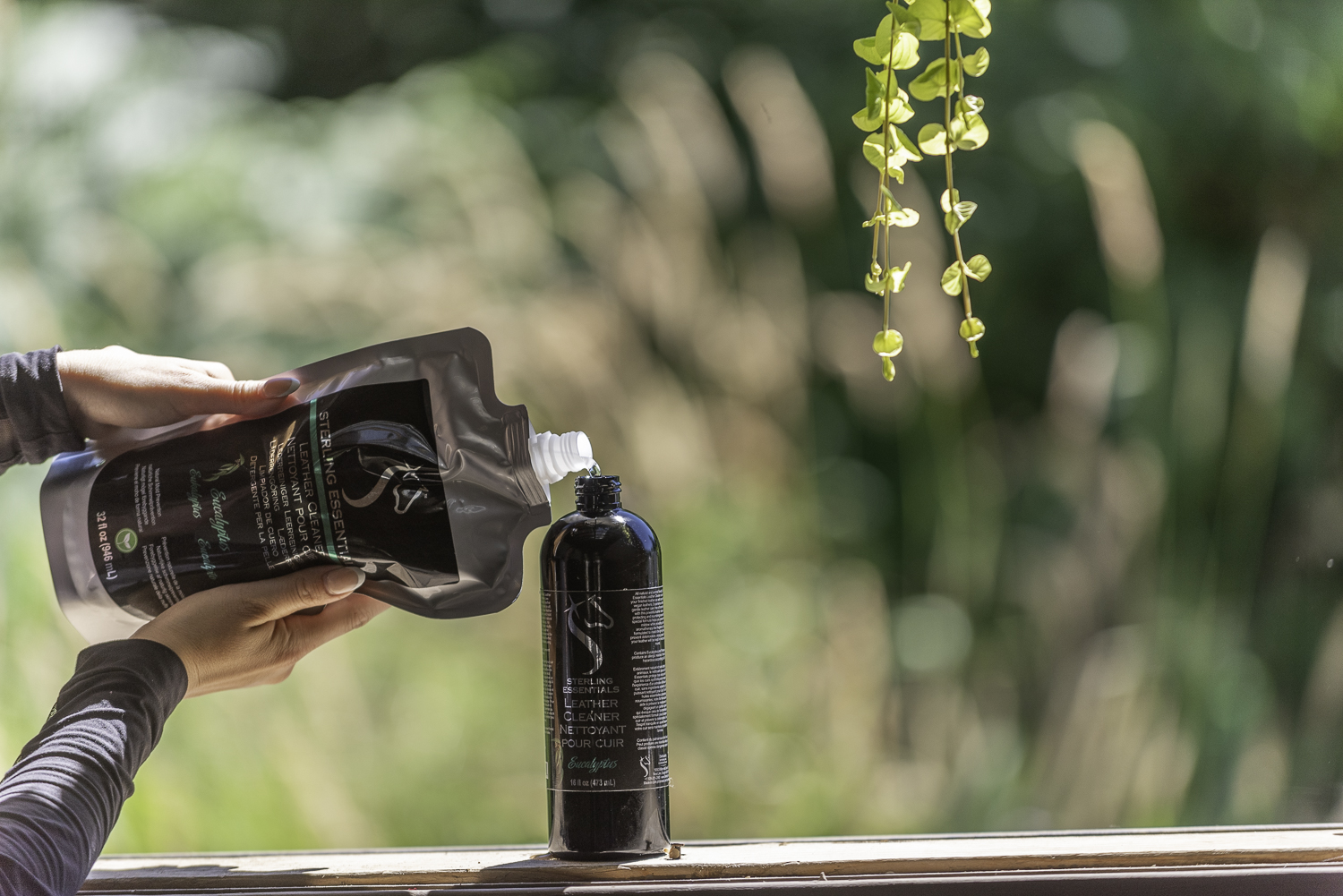
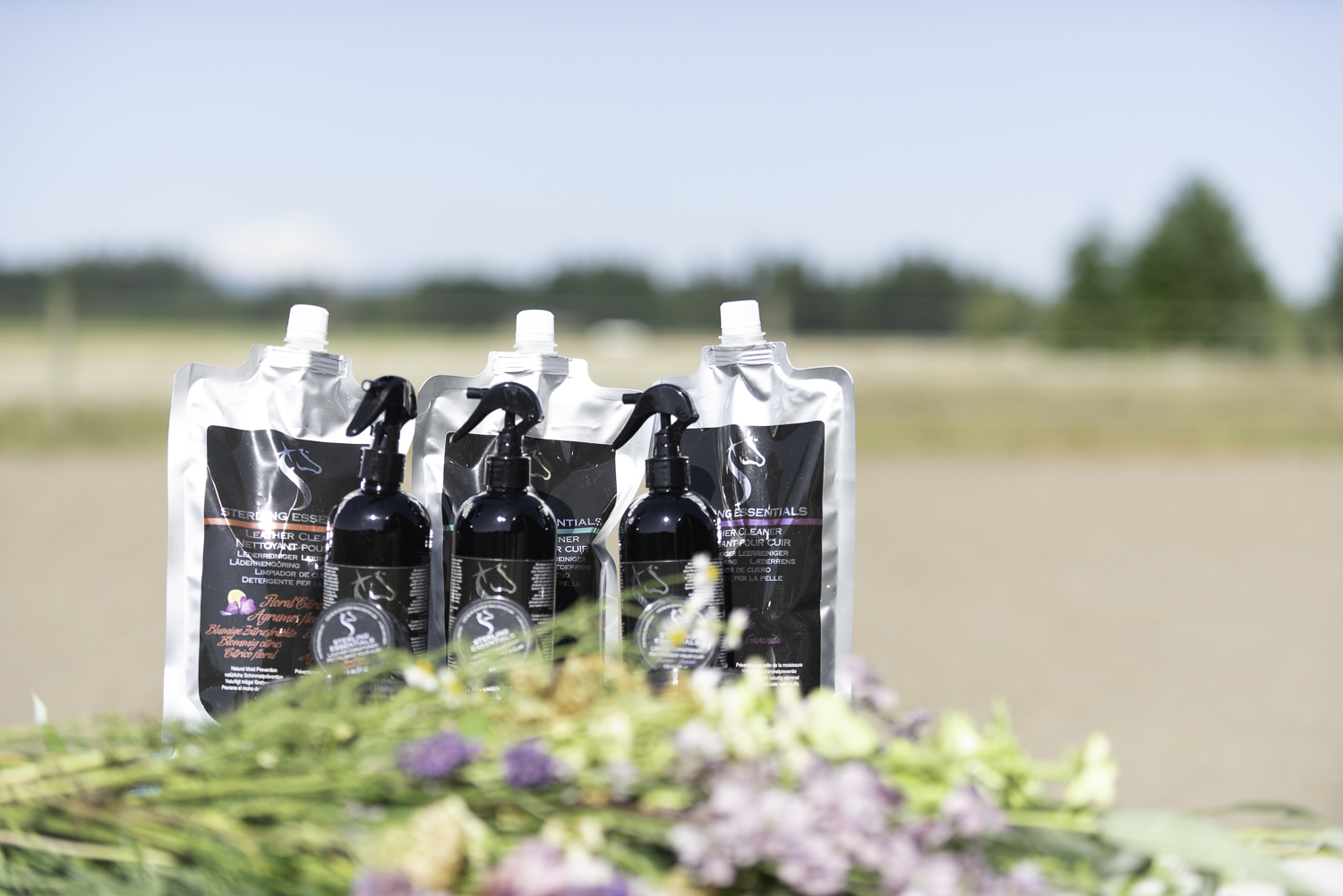
Tell me about the process of testing products! (scents, ingredients, etc)
Oh, the development process was so fun! As an engineer with a background in product development and material science, I just loved nerding out on testing and science. LOL! Quite a bit of research and experimentation went into coming up with the perfect balances and blends of ingredients for all of our products. In addition to ensuring our products used natural and gentle ingredients, I approached our blends from a scientific perspective, as well.
Leather has certain compositions and properties that must be respected and maintained if the leather is to stay sound and in working condition for years. Delving into the science of leather was fascinating, and it helped me come up with our special pH-matched formulation specifically designed to protect and nurture leather’s key properties. Additionally, results from clinical trials and other studies guided us to the best essential oils for preventing mold and mildew. Once the critical oils were selected, I had a lot of fun with family and my barn mates coming up with the product fragrance combinations. After mixing, spraying, and smelling sample after sample until we got it right, my house and the barn certainly smelled really good!
Throughout the whole process, I constantly asked myself, “Does it smell good, as if I’m at an aromatherapy spa? Would I want to use these products every day? Am I comfortable getting these products all over my bare hands? How about on my face? Am I worried if this gets on my horse or if he eats some product? Do they actually, really truly work? And work well?” I wasn’t satisfied until I could say “yes” to all of these questions and more because then I knew our products were checking all of the boxes that equestrians are looking for in a high quality leather care product.
What’s your favorite thing about your business?
The freedom, peace, and autonomy I now have as an entrepreneur is such a blessing, and I love my life. But I love that first and foremost my business lets me help my horses and improve their lives. Likewise, I just love contributing a solution to help fellow equestrians, barn mates, and their horses enjoy a healthier equestrian experience and tackle their tack care struggles.
Everything leads to something, too, so it’s been wonderful to meet and work with riders and equestrian businesses all over the world, too. This has really expanded my awareness of our equestrian community, and even more excitedly, also led me to start my newest business providing transformational coaching for fellow equestrian entrepreneurs. Because it’s really about helping lift each other up and raising all boats, isn’t it? And I’m grateful to my businesses for helping me have the opportunity to work to leave this world a little better than I found it.

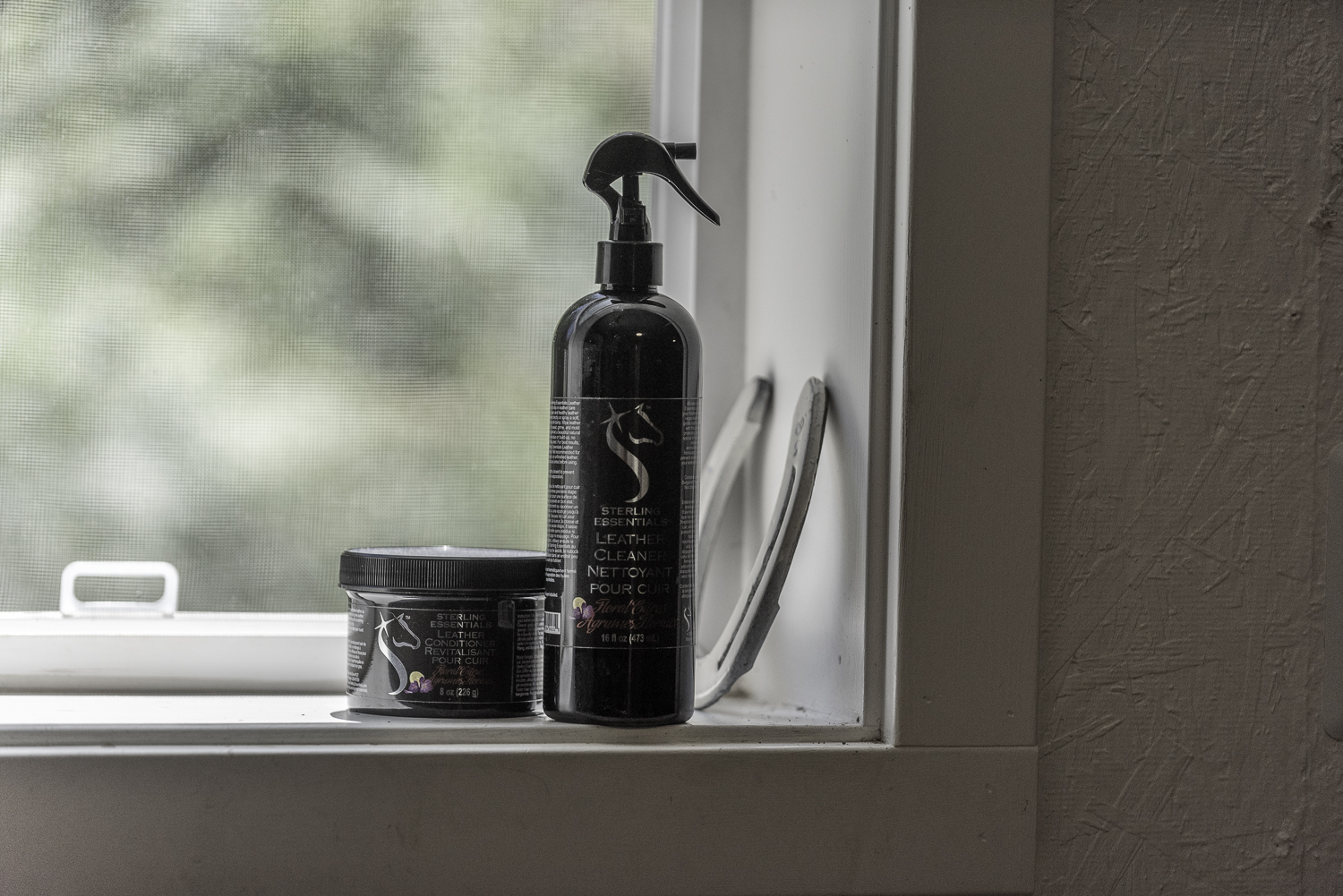
What’s a part of the equestrian industry that you feel like people either don’t know a lot about or talk about?
Our sport and industry are not alone in having some resistance to change or a slow pace in adopting new ideas and methods to become the new “norms”. Although receiving more attention than in years past, the mainstream of the equestrian industry still does not appear to talk very much about alternative approaches, methods, and options in horse care and training. Some of the more well-known topics in this area of more traditional versus alternative care include shoes versus shoeless or bits versus bitless. Another example would be all-natural products with animal-friendly and environmentally conscious ingredients as an alternative to many of the more common products in the marketplace that are often less friendly to our horses’, our own, and our environment’s health.
Visit sterling-essentials.com to shop and learn more!

